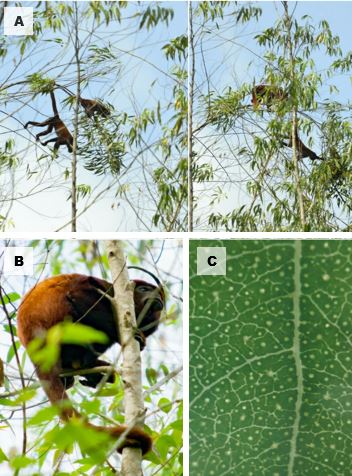Abstract
It has been reported that some simple and complex production systems can be used as temporary or permanent habitats by some primates. In southern Mexico and Brazil, it has been reported that forest plantations of Eucalyptus sp could maintain populations of Alouatta spp. However, there are aspects of the use of productive areas that have not been described. Therefore, it is important to explore how primates use these spaces, to generate useful information in the formulation of management and conservation plans for the species. Here, we report the observation of a group of Alouatta seniculus in rest, and displacement activities in forest plantations of Eucalyptus urograndis in the department of Antioquia, Colombia, from occasional observations.
References
Agostini I, Holzmann I, di Bitetti MS. 2010. Are howler monkey species ecologically equivalent? trophic niche overlap in syntopic Alouatta guariba clamitans and Alouatta caraya. American Journal of Primatology. 72(2):173–186. https://doi.org/10.1002/ajp.20775
Barboza C. 2008. Estratégias adaptativas de um grupo de bugios-pretos, Alouatta caraya (Humboldt, 1812), em um bosque dominado por eucaliptos. Universidade católica do rio grande do sul.
Bicca-Marques JC. 2003. How do Howler Monkeys Cope with Habitat Fragmentation? Msrsh LK, editor. Primates in Fragments.(2000):283–303. https://doi.org/10.1007/978-1-4757-3770-7_18
Bonilla-Sánchez YM, Serio-Silva JC, Pozo-Montuy G, Chapman CA. 2012. Howlers Are Able to Survive in Eucalyptus Plantations Where Remnant and Regenerating Vegetation Is Available. International Journal of Primatology. 33(1):233–245. https://doi.org/10.1007/s10764-011-9569-9
Defler T, Stevenson P, Bueno M, Guzmán-Caro D. 2013. Primates Colombianos en Peligro de Extinción. I. Defler T, Stevenson P, Bueno M, Guzmán D, editors. Bogotá: Editorial Panamericana.
Defler TR. 2013. Aspectos sobre la conservación de los primates colombianos: ¿cuál es el futuro? Primates Colombianos en Peligro de Extinción.:2–21.
Estrada A, Raboy BE, Oliveira LC. 2012. Agroecosystems and Primate Conservation in The Tropics: A Review. American Journal of Primatology. 74(8):696–711. https://doi.org/10.1002/ajp.22033
Gómez-Posada C. 2006. Plan de conservación del mono aullador rojo (Alouatta seniculus) en la región del Sirap-EC y Valle del Cauca. Editores. Valderrama C, Kattan C, Bogotá. Instituto de Investigación de Recursos Biológicos Alexander von Humboldt, Fundación EcoAndina, WCS Colombia.
Henao Días et al. 2020. Atlas de la Biodiversidad de Colombia: Primates. In: Instituto de Investigación de Recursos Biológicos Alexander von Humboldt. Bogotá D.C, Colombia. p. 51.
IDEAM. 2017. Promedios Climatológicos 1981 - 2010. http://www.ideam.gov.co/web/tiempo-y-clima/clima. Accessed on 11 September 2021.
López M. 2004. Los aceites esenciales | Offarm. Elseiver. 23(7):88–91.
Mesa-sierra N, Perez-t J. 2017. Calidad estructural y funcional de espacios usados por Alouatta seniculus en fragmentos de bosque seco tropical (Córdoba, Colombia). Neotropical Primates. 23(2):9-15
Parra C. 2014. Sinopsis de la familia Myrtaceae y clave para la identificación de los géneros nativos e introducidos en Colombia. Revista de la Academia Colombiana de Ciencias Exactas, Físicas y Naturales. 38(148):261–277.

This work is licensed under a Creative Commons Attribution 4.0 International License.






